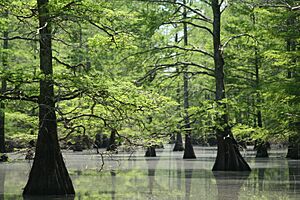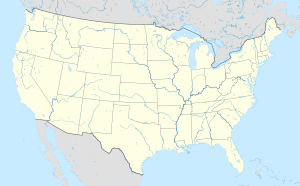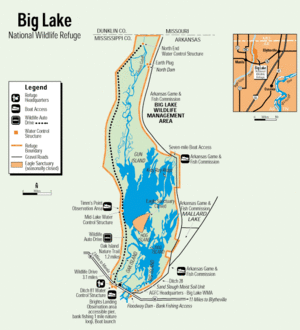Big Lake National Wildlife Refuge facts for kids
Quick facts for kids Big Lake National Wildlife Refuge |
|
|---|---|
|
IUCN Category IV (Habitat/Species Management Area)
|
|
| Location | Mississippi County, Arkansas, United States |
| Nearest city | Manila, Arkansas |
| Area | 11,047 acres (44.71 km2) (2014) |
| Established | 1915 |
| Governing body | U.S. Fish and Wildlife Service |
| Website | Big Lake National Wildlife Refuge |
Big Lake National Wildlife Refuge is a special place in Mississippi County, Arkansas, United States. It is a huge area, about 11,047 acres, managed by the United States Fish and Wildlife Service. This refuge is mostly a shallow lake, swampy areas, and forests. Its main job is to protect homes for waterfowl (like ducks and geese) in a region where lots of farming happens. Part of Big Lake is even called a National Natural Landmark, which means it is a very important natural area.
History of Big Lake
Before some big earthquakes in 1811 and 1812, the Little River flowed freely through this flat land. These earthquakes changed how the water flowed and created Big Lake. Early settlers called this area the "Great Swamp." It was full of tall bald cypress trees, other forests, and open water.
After the American Civil War, railroads came to the area. People started cutting down trees. The Big Lake area was also popular with hunters because of its many waterfowl. Some hunters killed animals like white-tailed deer and ducks to sell the meat. Hunting clubs also bought large areas for sport hunting.
This caused problems with local people who hunted to feed their families. These locals, who were often poor, could no longer use the land bought by hunting clubs and timber companies. This led to conflicts called the "Big Lake Wars" from the 1870s to 1915. There were legal fights, actual fights, shootings, and clubhouses were even burned.
In the early 1900s, rice farming grew in Arkansas. Soon, the land around Big Lake was covered with levees and ditches for farming. Big Lake became like an island in a sea of farms. In 1915, wildlife numbers were dropping, and farming was increasing. So, the U.S. government created Big Lake National Wildlife Refuge. It was one of the first inland federal wildlife refuges ever made.
A large network of man-made ditches in Missouri drains a lot of former swamp land. This drainage affects the refuge. Silt (fine dirt) from farms was flowing into Big Lake. But in the 1990s, the U.S. Army Corps of Engineers worked to send this silt-filled water around the refuge. This has made the water cleaner, and wildlife numbers have grown.
Life at the Refuge
Big Lake is usually only about three feet (one meter) deep. The refuge has about 8,138 acres of open water mixed with wooded swamp areas. Most of the rest of the land gets flooded at certain times of the year. When there are big floods, almost all of the refuge can be underwater.
The lake is surrounded by an old forest of tupelo and bald cypress trees. Drier parts of the refuge also have forests with different kinds of trees. These include several types of oak, green ash, cottonwood, river birch, and red maple.

Big Lake is a very important stop for waterfowl that spend the winter there or are just passing through. Sometimes, as many as 200,000 birds can be found there in winter. Wood ducks live here all year, and about 2,500 ducklings are born each year. Bald eagles started nesting at the refuge in 1993. About 227 different kinds of birds have been seen here.
Other animals living at the refuge include the river otter, beaver, raccoon, wild turkey, white-tailed deer, bobcat, and sometimes even an armadillo. The largest largemouth bass ever caught in Arkansas, weighing over 16 pounds, was caught in the refuge in 1976.
The refuge is open to visitors all year. However, it might close during floods to keep people safe.
Nearby Protected Areas
Next to the refuge on the north side is the Hornersville Swamp Conservation Area. The Missouri Department of Conservation owns and manages this area. It is about 3,166 acres and is also protected for native wildlife.
On the east side of the refuge is the Big Lake Wildlife Management Area. The state of Arkansas owns this area. It is about 12,320 acres and is open for hunting deer, waterfowl, and small game. This area is mostly bottomland hardwood forests. Both of these nearby areas can also experience flooding.



